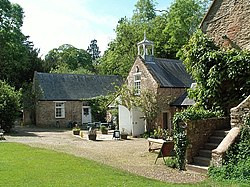Fyne Court
| Fyne Court | |
|
National Trust | |
|---|---|
 The café and shop at Fyne Court | |
| Grid reference: | ST224321 |
| Location: | 51°4’50"N, 3°6’52"W |
| Information | |
Fyne Court is a wild estate garden in Somerset now owned by the National Trust and operated by the Trust as a nature reserve and visitor centre. It is by Broomfield in the Quantock Hills in the middlemost part of the county.
Fyne Court was once a grand country house which belonged to the Crosse family since its construction, although the date when it was built is not known. The garden was part of the estate.
Andrew Crosse conducted a series of experiments with electricity, including the development of large voltaic piles, at the house during his ownership in the early 19th century.
The main building of Fyne Court burnt down in 1894. The buildings which survived the fire have been used as offices and a visitor centre by organisations such as the Somerset Wildlife Trust and Quantock Hills Area of Outstanding Natural Beauty Service since it came into the ownership of the National Trust in 1967. It is surrounded by a large country estate of woodland, ponds and meadows. Within the grounds are a folly and boathouse.
History

The nature reserve is set in parkland which was originally the pleasure grounds of a large house belonging to pioneer 19th-century electrician, Andrew Crosse,[1] whose family had owned the house from its construction.[2]
Having lost his parents, his father in 1800 and his mother in 1805, Crosse took over the management of the family estates at the age of 21. Among his experiments Crosse erected "an extensive apparatus for examining the electricity of the atmosphere," incorporating at one point an insulated wire a mile and a quarter long, later shortened to 1,800 feet, suspended from poles and trees. Using this wire he was able to determine the polarity of the atmosphere under various weather conditions. His results were published by his friend George Singer in 1814, as part of Singer's Elements of Electricity and Electro-Chemistry.[3]
Along with Sir Humphry Davy (who visited Fyne Court in 1827), Crosse was one of the first to develop large voltaic piles.[4] Although it was not the largest he built, Henry Minchin Noad's Manual of Electricity describes a battery consisting of 50 jars containing 73 square feet of coated surface. Using his wires Crosse was able to charge and discharge it some 20 times a minute, "accompanied by reports almost as loud as those of a cannon".[3] He became known locally as "the thunder and lightning man".[5] In 1836 Sir Richard Phillips described seeing a wide variety of voltaic piles at Fyne Court, totalling 2,500, of which 1,500 were in use when he visited.[6]
The house burnt down in 1894.[7] However the detached music room in which Crosse conducted his experiments survived,[8] along with some of the books and oil paintings by Anthony van Dyck and Peter Paul Rubens.[9] The laboratory table on which Crosse carried out experiments stands in the aisle of the Church of St. Mary and All Saints in Broomfield and an obelisk in his memory is in the churchyard.[10]
In 1918 several hundred acres of the woodland within the park was sold at an auction in Taunton.[11]
Fyne Court has been in the ownership of the National Trust since 1967 and was used as the headquarters of the Somerset Wildlife Trust.[12] The Quantock Hills AONB Service have their headquarters in the grounds.[13]
Grounds

Fyne Court is surrounded by a 65-acre estate.[14]
Much of the landscaping, including an arboretum laid out in 1780, has become overgrown and now provides varied habitats including broadleaved woodland, ponds and meadows grazed by highland cattle. The site is home to over 100 species of fungi and some rare invertebrates.[12] In the grounds is a folly with two 13-foot wide crennelated towers, and a boathouse.[15]
Outside links
| ("Wikimedia Commons" has material about Fyne Court) |
- Fyne Court - information at the National Trust
References
- ↑ Fyne Court – National Trust}}
- ↑ Bush, Robin (1994). Somerset: The complete guide. Wimborne, Dorset: Dovecote Press. p. 46. ISBN 1-874336-26-1.
- ↑ 3.0 3.1 Crosse, Cornelia A H (1857). Memorials scientific and literary of Andrew Cross, the electrician. London: Longman, Brown, Green, Longmans and Robert.
- ↑ Encyclopædia Britannica, 1911 edition, Volume V09, Page 185
- ↑ "Andrew Crosse: The man and the myth". National Trust. http://www.nationaltrust.org.uk/wra-1356292904077/369643/. Retrieved 22 January 2015.
- ↑ Pocock RF (May 1993). "Andrew Crosse : Early nineteenth-century amateur of electrical science". IEE Proceedings-A 140 (3).
- ↑ Waite, Vincent (1964). Portrait of the Quantocks. London: Robert Hale. pp. 38–42. ISBN 0-7091-1158-4.
- ↑ "Fire at Fyne Court". National Trust. http://www.nationaltrust.org.uk/wra-1356292904077/369670/. Retrieved 9 February 2014.
- ↑ {{cite news|title=The Destruction by Fire of Fyne Court, Bridgwater|url=http://www.britishnewspaperarchive.co.uk/viewer/bl/0000264/18940904/014/0003%7Cwork=Western Daily Press|date=4 September 1894| publisher=British Newspaper Archive
- ↑ National Heritage List 1058934: Church of St. Mary and All Saints
- ↑ "The Fyne Court Estate". Taunton Courier, and Western Advertiser (British Newspaper Archive). 13 November 1918. http://www.britishnewspaperarchive.co.uk/viewer/bl/0000527/19181113/041/0004.
- ↑ 12.0 12.1 "Broomfield". Quantock Online. http://www.quantockonline.co.uk/quantocks/villages/broomfield/broomfield1.html. Retrieved 29 August 2011.
- ↑ "Fyne Court". Exmoor Encyclopedia. http://www.everythingexmoor.org.uk/encyclopedia_detail.php?ENCid=458. Retrieved 22 January 2015.
- ↑ "Acquisitions up to December 2011". National Trust. p. 13. http://www.nationaltrust.org.uk/cs/Satellite?blobcol=urldata&blobheader=application%2Fpdf&blobheadername1=Content-Disposition&blobheadername2=MDT-Type&blobheadername3=Content-Type&blobheadervalue1=inline%3B+filename%3D297%252F965%252Fnt_acquisitions_dec2011-2%252C2.pdf&blobheadervalue2=abinary%3B+charset%3DUTF-8&blobheadervalue3=application%2Fpdf&blobkey=id&blobtable=MungoBlobs&blobwhere=1349117284549&ssbinary=true. Retrieved 19 April 2015.
- ↑ Holt, Jonathan (2007). Somerset Follies. Bath: Akeman Press. pp. 54–55. ISBN 9780954613877.